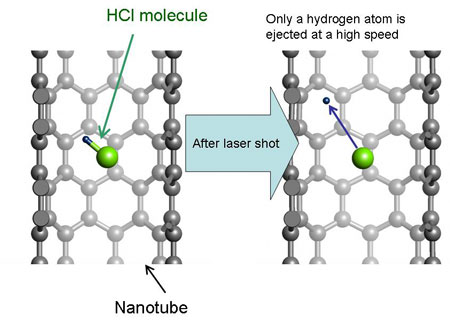| Dec 28, 2010 |
'Earth Simulator' succeeds in the world's first simulation-based prediction of photochemical reactions inside carbon nanotubes
|
|
(Nanowerk News) NEC Corporation announced that it succeeded in the world's first simulation-based prediction of laser-induced photochemical reactions that can efficiently eject a hydrogen atom from a hydrogen chloride molecule trapped inside a carbon nanotube. The simulation was conducted on the "Earth Simulator" which NEC deployed for the Japan Agency for Marine-Earth Science and Technology (JAMSTEC), an independent administrative organization.
|
|
These results are expected to pave the way for the quantity synthesis of not only hydrogen, but also inexpensive materials through the facilitation of known photochemical reactions due to the laser pulse irradiation, as well as the development of new materials.
|
|
Results were published online on December 7 by the Physical Review Letters, a prestigious academic journal of the American Institute of Physics.
|
 |
| Dissociation of hydrogen chloride (HCI) molecule trapped inside a carbon nanotube due to the laser pulse irradiation.
|
|
The Earth Simulator topped the HPC Challenge Award for Fast Fourier Transform (FFT) performance at the SC10 supercomputing conference held in the United States in November 2010. The Earth Simulator demonstrated the world's top-level computing efficiency, especially for complicated applications, including nanoscience, quest for new materials and weather prediction.
|
|
The FFT dominates almost half of the processing in the application software used for this research. The Earth Simulator significantly reduced the computing time needed for laser pulse irradiation; taking just two days in contrast to the several months required by conventional supercomputers. As a result, it is now possible to determine the optimum laser intensity in a realistic timeframe with a series of simulations for variable laser intensities.
|
|
This research was carried out under a collaborative research contract with JAMSTEC titled "Large-scale Simulation of Characteristics of Carbon Nanotubes."
|
|
The application fields of the Earth Simulator, with its outstanding sustained performance, span a wide range of areas. For example, it contributes to more accurate climate change projections and the comprehensive understanding of environmental issues, such as the assessment of the effects of global warming for the fifth report of the Intergovernmental Panel on Climate Change (IPCC), as well as prevention and mitigation of natural disasters through high-resolution simulations of earthquakes and seismic surges. Moreover, the Earth Simulator is utilized heavily in tackling energy issues and developing new materials by leveraging cooperative relations with industry partners.
|
|
Looking forward, NEC aims to support leading-edge research and development capitalizing on advanced supercomputers, such as the Earth Simulator, with superior HPC technologies.
|

